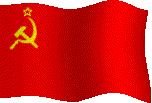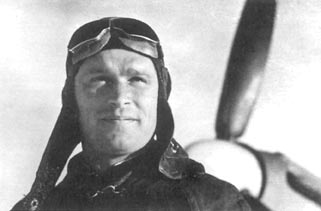
 Boris Safonov's "British Show"
Boris Safonov's "British Show" 

 Boris Safonov's "British Show"
Boris Safonov's "British Show" 
The best known Soviet fighter ace during the first period of the war, was young Boris Safonov, who flew with 72 SAP (Composite Aviation Regiment) of the Air Force of the Soviet Northern Fleet (VVS SF) in the Murmansk area in the far North.
Before his death on May 30, 1942, Safonov scored 17 victories, of which at least eight can be verified by Luftwaffe loss records. During his last combat, he was credited with another three kills--bringing his total to 20 (according to his logbook; higher figures are given in various Soviet publications).
What makes Safonov's achievement remarkable is that 14 of these victories were claimed during the three first months of the war, while Safonov was flying an I-16 Ishak fighter, an airplane far inferior to the German Messerschmitt 109s. During a stay by RAF fighter pilots in this area in the fall of 1941, Boris Safonov gave the British airmen an impressive show of combat skill.

In September 1941, the Air Force of the Soviet Northern Fleet was reinforced
with thirty-nine British Hawker Hurricane fighters of Wing Commander H. N. G.
Ramsbottom-Isherwood's 151 Wing, including 81 and 143 squadrons. Twenty-four
were flown to Murmansk and fifteen to Arkhangelsk.
The British were eager to avenge their humiliating defeat in the air over the same area on July 30, 1941, when German fighters shot down 15 British aircraft sent out from the carriers Victorious and Furious - without a single German loss.
On September 12, 1941, the twenty-four Hurricanes bound for Murmansk took off from the aircraft carrier Argus in the Barents Sea . That same afternoon, the British pilots of 81 Squadron flew a combat mission over the front lines. They bounced five Messerschmitt 109s escorting a Henschel 126. In the ensuing action, the Messerschmitt pilot Leutnant Eckhard von der Lühe and the Hurricane pilot Sergeant Smith were both shot down and killed. (The British pilots claimed to have shot down three Bf 109s plus the Hs 126. During the following five weeks, the RAF pilots took part in several combats, claiming 16 confirmed victories, 4 "probables," and 7 damaged enemy aircraft--a high over-claim--for the loss of only 2 Hurricanes.)
In the hands of an expert, the old I-16 was still to be reckoned with, as Boris Safonov would show the British guests. On September 6, 1941, the Luftwaffe raided 72 SAP´s airfield. Safonov and four other I-16 pilots met the attackers in the air, claiming two Ju 87s shot down. While clashing with the escorting Bf 109s, one I-16 pilot was credited with one kill while another "Messer" was shared by Safonov and a third pilot. According to the Soviet report, a third Messerschmitt crashed into the ground while chasing the agile I-16s. None of these claims can be verified in the loss tables of JG 5 (which are not necessarily complete).
Three days after the arrival of the British airmen--on September 15, 1941--Safonov decided to demonstrate his abilities. This was to become Safonov´s most successful day: A Schwarm of Messerschmitt 110s from 1.(Z)/JG 77 was out on an escort mission for the Stukas of Hauptmann Arnulf Blasig´s IV.(St.)/LG 1, which were attacking Soviet ground troops in the Zapadnaya Litsa region. Leutnant Heinz-Horst Hoffmann, the pilot in one of the Bf 110s, spotted a lone I-16 below. Hoffmann was one of the veterans of the Zerstörerstaffel, with three victories to his credit.Without hesitating, he put the nose of his twin-engine fighter down to make an attack.
Hoffmann didn´t see the trap until it was too late. A dark green I-16 with the bold inscription "Smert fashistam!" ("Death to fascism!") painted in two-feet-high red letters on the side of the fuselage came arrowing down from above. It was Boris Safonov's "White 11." Hoffmann's Bf 110 was hit in an engine. The plane made a roll and went down from low altitude, exploding on impact three miles west of Zapadnaya Litsa. Having scored his 12th victory, Safonov turned against the Stukas. One of them went down in flames, Safonov´s 13th victory. Shortly afterwards, the Russian ace caught a third German plane, an Hs 126, and shot it down as well. On the following day, Boris Safonov received the highest Soviet award, the Golden Star--the token of the Hero of the Soviet Union.
As the British pilots left for home, the Hurricanes were naturally handed over to 72 SAP. With better equipment, the Soviet fighter pilots were able to inflict growing losses upon the small Luftwaffe forces on the "Polar Front." Marking the end of 1941, Boris Safonov, flying a Hurricane fighrer, claimed one Messerschmitt 109 on December 17, 1941, and one He 111H-5 (piloted by Unteroffizier Engelbert Roithmayr of 1./KG 26) on December 31, 1941.
Boris Safonov went missing in action after pursuing a group of II./KG 30 Ju 88s over the convoy PQ 16 off Murmansk on May 30, 1942. On June 14, 1942, Safonov posthumously became the first Soviet citizen to be twice appointed Hero of the Soviet Union during the war against Germany.
A detailed account of Safonov's last combat - plus his victory list, and a color profile of the Curtiss P-40 E in which he made his last flight - is presented in Vol. 2 of Black Cross/Red Star.
© Christer Bergström, Andrey Mikhailov 2000 - 2002.
See also: